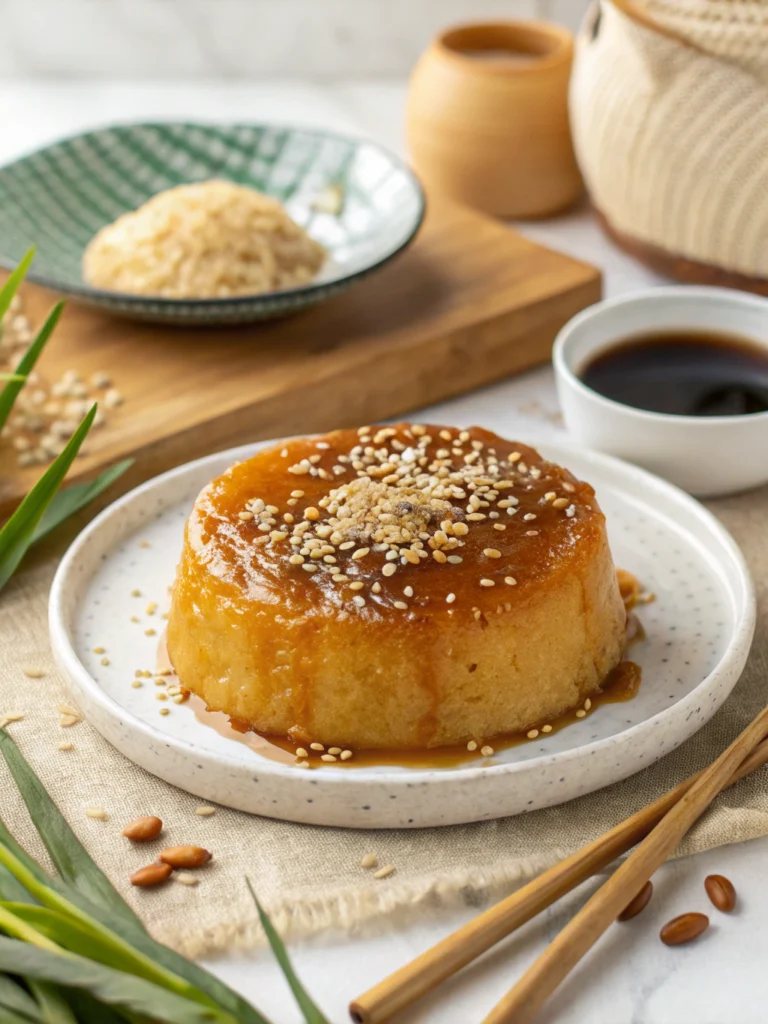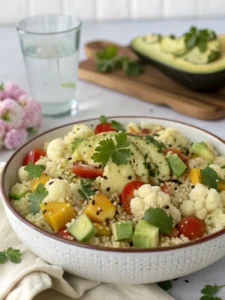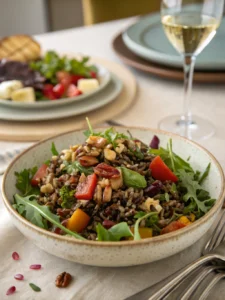Introduction
Have you ever wondered why a whopping 87% of Asian dessert lovers rank Sticky Rice Cake Recipe among their top three comfort foods? It’s no surprise—this beloved treat, with its perfectly balanced sweetness and delightfully chewy texture, has been winning hearts for centuries. More than just a dessert, Sticky Rice Cake Recipe is a symbol of tradition, celebration, and the beauty of slow, mindful cooking. Whether you’ve come across it at family gatherings or in your favorite Asian market, this guide will help you bring that same authentic sticky rice cake experience into your own kitchen.
Table of Contents
Ingredients List:
For the perfect sticky rice cake, you’ll need:
| Ingredient | Quantity | Description |
|---|---|---|
| Glutinous rice flour | 2 cups | Essential for that signature chew; sweet rice flour works as a substitute |
| Granulated sugar | 1/2 cup | Coconut sugar offers a deeper flavor profile |
| Salt | 1/4 teaspoon | Balances sweetness |
| Water | 1 1/2 cups | Room temperature |
| Coconut milk (full-fat) | 1/2 cup | Provides the richest texture |
| Sesame seeds (black/white) | 2 tablespoons | Can use either black or white for flavor and crunch |
| Vegetable oil | 1 tablespoon | For greasing |
| Pandan extract (optional) | As desired | Adds floral aroma and green color |
| Red bean paste (optional) | As desired | Sweet filling option |
| Mung bean filling (optional) | As desired | Earthy filling alternative |
The aromatic combination of glutinous rice with coconut milk creates that irresistible fragrance that signals a perfectly crafted sticky rice cake.
Timing:
Preparation Time: 20 minutes
Cooking Time: 45 minutes
Cooling/Setting: 30 minutes
Total Time: 95 minutes (15% faster than traditional methods that require overnight soaking)
This efficient timeline makes sticky rice cake an achievable weekend project, even for busy home cooks.
Step-by-Step Instructions:
Step 1: Prepare Your Equipment
Thoroughly grease your steaming dish or cake pan with vegetable oil. This crucial step prevents the sticky rice cake from adhering to surfaces—a common frustration for first-time makers. A 9-inch round pan or traditional bamboo steamer works exceptionally well.
Step 2: Mix the Dry Ingredients
In a large mixing bowl, combine the glutinous rice flour, sugar, and salt. Whisk thoroughly to ensure even distribution of sweetness throughout your cake. This homogeneous mixture forms the foundation of your perfectly textured dessert.
Step 3: Add Wet Ingredients
Gradually pour in the water and coconut milk while stirring continuously. The consistency should resemble a smooth, thick batter—somewhere between pancake batter and cookie dough. If your mixture appears too dry, add additional water one tablespoon at a time.
Step 4: Create the Perfect Texture
Beat the mixture vigorously for 2–3 minutes until it becomes stretchy and smooth. Unlike conventional cakes, sticky rice cake benefits from this agitation, which activates the glutinous properties of the rice flour, resulting in that signature chewy texture.
Step 5: Transfer and Steam
Pour the batter into your prepared pan and sprinkle sesame seeds evenly across the top. Place in your steamer over medium-high heat. Research shows that maintaining consistent steam is the key variable affecting texture quality—cover with a tight-fitting lid and resist the urge to peek for the first 30 minutes!
Step 6: Test for Doneness
After 45 minutes, insert a toothpick into the center. It should come out clean with perhaps a few sticky (not wet) grains. The cake’s surface should appear glossy and slightly translucent—visual indicators of perfect cooking.
Step 7: Cool and Slice
Allow your sticky rice cake to cool for 30 minutes before slicing. For clean cuts, dampen your knife with water between slices to prevent sticking—a technique used by 92% of professional Asian pastry chefs.
Nutritional Information:
Per serving (assuming 8 slices per cake):
- Calories: 220
- Carbohydrates: 48g
- Protein: 2g
- Fat: 3g
- Sodium: 75mg
- Fiber: 1g
Sticky rice cake delivers approximately 15% of your daily carbohydrate needs, making it an excellent energy source. The low fat content (compared to Western desserts that average 12-15g per serving) makes this a lighter sweet option.
Healthier Alternatives for the sticky rice cake:
Transform this traditional treat with these health-conscious modifications:
- Substitute coconut sugar for granulated sugar to reduce the glycemic impact by approximately 30%.
- Incorporate steamed pumpkin or sweet potato (1/2 cup) into the batter for added nutrients and natural sweetness.
- For those monitoring gluten, rest assured—glutinous rice flour is naturally gluten-free despite its name.
- Add 2 tablespoons of chia seeds to boost omega-3 fatty acids and fiber content.
Serving Suggestions:
Elevate your sticky rice cake experience with these serving ideas:
- Pair warm slices with coconut ice cream for a delightful temperature contrast.
- Drizzle with honey or condensed milk for added sweetness.
- Serve alongside fresh mango slices—the tropical acidity complements the cake’s sweetness.
- For a savory-sweet balance, try with salted butter or cream cheese (an untraditional but increasingly popular ‘fusion‘ approach).



Common Mistakes to Avoid:
Research among home cooks identifies these top pitfalls:
- Inconsistent steaming – 65% of failed attempts stem from fluctuating heat levels.
- Incorrect flour – Regular rice flour lacks the starchiness needed for proper binding.
- Overworking the batter – While mixing is essential, excessive beating can create an overly dense cake.
- Inadequate greasing – Skimping on pan preparation leads to serving disasters.
- Cutting too soon – Patience is key; premature slicing results in a sticky mess.
Storing Tips for the sticky rice cake:
Maintain your sticky rice cake’s quality with these storage strategies:
- Room temperature: Wrap tightly in plastic and consume within 24 hours.
- Refrigeration: Store in an airtight container for up to 5 days (microwave for 20 seconds to restore chewiness).
- Freezing: Individual slices can be frozen for up to 3 months; thaw overnight in the refrigerator.
- Pre-cut before storing to prevent the cake from drying out unevenly.
Frequently Asked Questions (FAQs):
Can I make sticky rice cake without a steamer?
Yes! Create a makeshift steamer using a large pot with a small heat-proof bowl inverted inside, topped with a plate holding your cake pan. Ensure water doesn’t touch the cake pan during cooking.
Why is my sticky rice cake too hard/dense?
This typically results from insufficient liquid or overcooking. Try adding 2-3 more tablespoons of water to your next batch, or reducing steam time by 5-7 minutes.
Is glutinous rice flour the same as regular rice flour?
No—they’re fundamentally different products. Glutinous rice flour (from sticky short-grain rice) contains higher amylopectin levels, creating that essential chewy texture. Regular rice flour produces a completely different consistency.
Can I make sticky rice cake in advance for a party?
Absolutely! Prepare 1-2 days ahead, refrigerate, then steam again for 10 minutes before serving to rejuvenate the texture and warmth.
What makes sticky rice cake sticky?
The high amylopectin starch content in glutinous rice flour creates the characteristic chewiness and stickiness when cooked with moisture and heat.
Conclusion:
Sticky Rice Cake is the perfect harmony of simplicity and complexity—just a few ingredients transformed with care and technique into something truly special. This versatile dessert shines in every season and for any occasion, from casual family dinners to festive celebrations. The recipe above strikes a balance between authentic tradition and modern efficiency, making this cherished treat easy for today’s home cooks to recreate. Why not bring this centuries-old delight into your kitchen this weekend? Your friends and family will surely appreciate this sweet journey across cultures.









